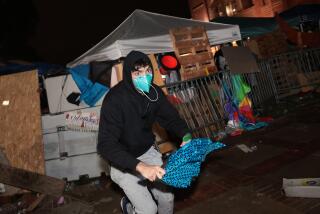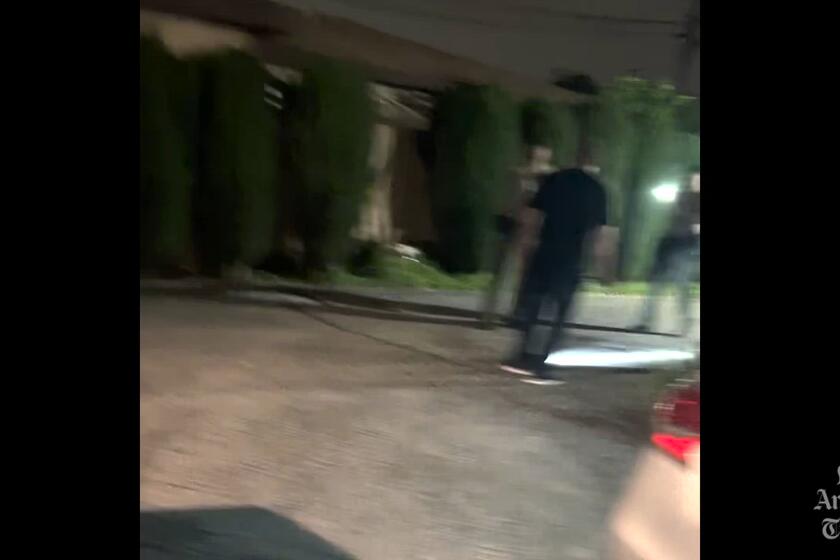Unarmed Volunteers to Patrol in Pomona
One day last week, Councilman Tomas Ursua looked outside his front window and saw a stranger running out of his garage with his new $125 saw. But he didn’t rush to the telephone to report the theft to police.
“I didn’t even bother calling because I knew it’d take all day for them to respond,” Ursua said Thursday.
Ursua and other city officials hope that a pilot program begun last week will scare off criminals such as the one he saw in front of his house.
The Citizen Patrol Program enlists volunteers to patrol crime-plagued areas of the city and report drug deals, theft and violent crimes to police as they happen.
Council Allocates Funds
The program, approved in concept by the City Council in May, got off the ground July 31 when council members unanimously voted to allocate $12,500 to train 20 volunteers and equip them with white patrol cars (former police cars repainted white) and khaki uniforms. The volunteers will be unarmed and will serve mainly as “extra eyes and ears” of the Police Department, said Ursua, who proposed the idea.
The concept behind the program is known as “visual deterrence”; the mere presence of a uniformed person driving a car with the Police Department’s seal emblazoned on the door could act as a deterrent to potential drug dealers, muggers and burglars. City officials hope the patrols will help stem the tide of crime in their city, where last year, 28 homicides, 54 rapes, 745 robberies and 1,303 aggravated assaults were committed.
“If there’s a burglary, for instance, the volunteer can show up in the front and turn the amber light on,” Ursua said. “The (burglar) isn’t going to check if it’s really a cop or not. And I (as a volunteer) would feel fairly comfortable following the guy so I can relay to the reserve officer where he’s going.”
Rigorous Screening
In addition to informing police of suspicious-looking situations, volunteers will be responsible for marking abandoned vehicles, assisting officers with traffic control and searches for missing persons, and other nonconfrontational duties.
Funding for the program comes at the same time the city is adding 19 patrol officers and five additional squad cars. Seven civilian officers will also be hired to handle routine investigations, thus freeing sworn officers to respond to more emergency calls. Currently, there are 171 sworn officers in the department.
Other San Gabriel Valley cities use volunteers to help with parking enforcement, keep an eye on vacationing owners’ houses and assist crossing guards, but do not put them on patrol. Ursua said Commerce is the only other city in Los Angeles County he knows of that uses volunteers as a visual deterrent to crime.
Police Chief Richard Tefank said potential volunteers will go through a rigorous screening process to ensure that they have high moral character, a clean driving record, and most important, to determine whether they have a criminal history. The 20 who are selected will then receive 40 hours of classroom instruction before going out in the field, first with a reserve officer in the car, then on their own.
Tefank stressed that he would “not place (volunteers) in a situation which would be a danger to them. Obviously, the reason is they’re unarmed.”
One council member, however, said the greatest need for more patrol cars is in hot crime spots, such as the northeast and southwest sections of Pomona, and city funds should not be spent on sending volunteers to safe neighborhoods.
“I don’t want them stuck in some place to watch the grass grow,” said Councilman C. L. (Clay) Bryant. “I want them out there in the heavy (crime) areas so they can report crime that’s tearing this city apart. They should volunteer with that in mind. This is not a program for old women.”
Originally, Ursua suggested that the volunteers drive black and white cars, but changed his mind after talking with police.
“We discovered there was a possible liability there, because people seeing the car would expect them to be able to take certain actions in a potentially lethal situation,” he said. “But a white car still has the psychological impact” of warding off potential criminals.
The application period for the program began Aug. 1 and will last about two weeks, Tefank said. Anyone 21 or older is eligible.
Ursua warned that overzealous volunteers may see themselves as “vigilantes” and try to assume the responsibilities of a law enforcement officer but said the screening process would minimize that possibility.
“We don’t want guys that are the jock-type of people coming in, because they’re not allowed to get in fights and so forth,” he said. “The radio is their biggest tool there.”
More to Read
Start your day right
Sign up for Essential California for news, features and recommendations from the L.A. Times and beyond in your inbox six days a week.
You may occasionally receive promotional content from the Los Angeles Times.






